A Comprehensive Guide To Safe Work Method Statements
Safe Work Method Statements (or SWMS) are frontline risk management documents that outline a safe method of work for high-risk construction activities.
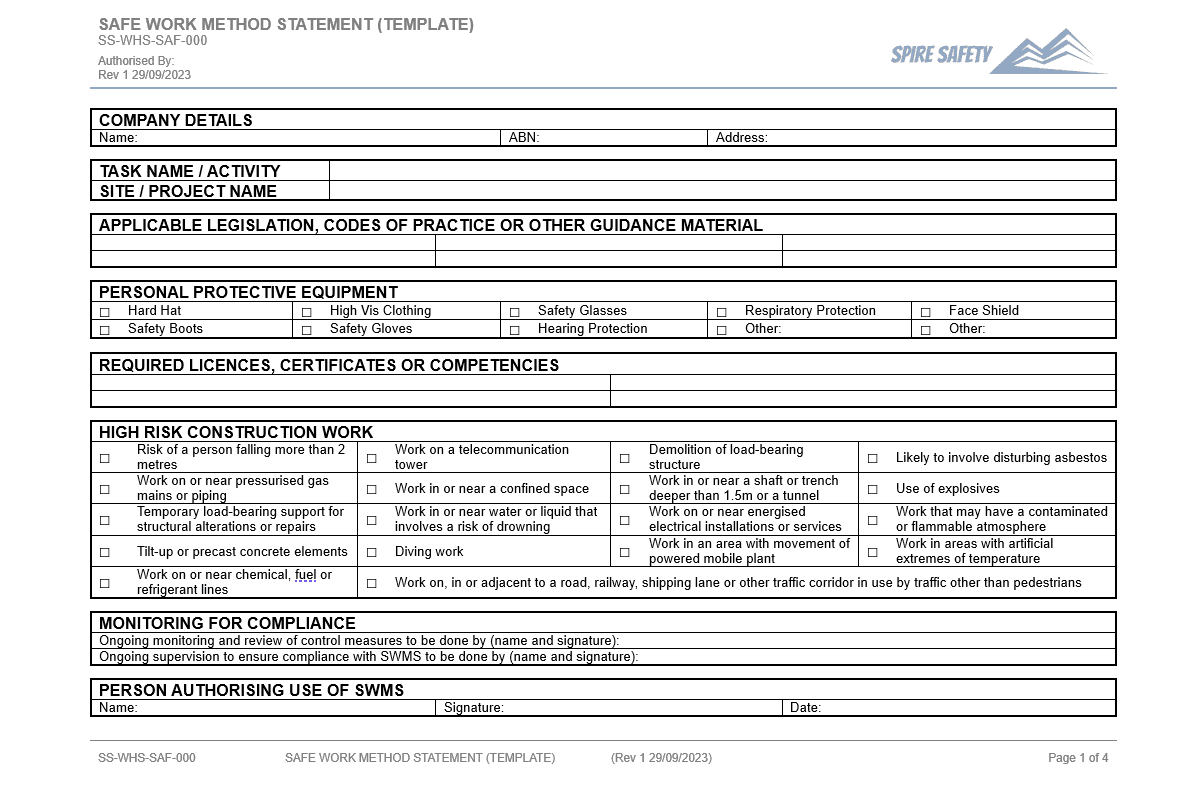
To download our SWMS template go to our Safe Work Method Statement Template.
*For internal use only. Not for resale or redistribution. By downloading, you agree to our Free Resources Licensing Agreement.
NOTE: This document is a template only and it must be customised for your business. Other aspects that may need to be considered include, but are not limited to, ensuring that:
- Relevant legal requirements have been met,
- Workplace specific risks are identified and managed, and
- Workers are consulted with during the customisation / review process.
Do You Need Safe Work Method Statements?
Legally, a PCBU (business / business owner) must ensure a Safe Work Method Statement is used for all for high-risk construction work. High-risk construction work is defined in s(291) WHS Regulations:
- involves a risk of a person falling more than 2 metres
- is carried out on a telecommunication tower
- involves demolition of an element of a structure that is loadbearing or otherwise related to the physical integrity of the structure
- involves, or is likely to involve, the disturbance of asbestos
- involves structural alterations or repairs that require temporary support to prevent collapse
- is carried out in or near a confined space
- is carried out in or near:
- a shaft or trench with an excavated depth greater than 1.5 metres
- a tunnel
- involves the use of explosives
- is carried out on or near pressurised gas distribution mains or piping
- is carried out on or near chemical, fuel or refrigerant lines
- is carried out on or near energised electrical installations or services
- is carried out in an area that may have a contaminated or flammable atmosphere
- involves tilt-up or precast concrete
- is carried out on, in or adjacent to a road, railway, shipping lane or other traffic corridor that is in use by traffic other than pedestrians
- is carried out in an area at a workplace in which there is any movement of powered mobile plant
- is carried out in an area in which there are artificial extremes of temperature
- is carried out in or near water or other liquid that involves a risk of drowning
- involves diving work
SWMS may be useful for other construction activities, even though they may not be legally required. Having a SWMS can help meet general legal duties, including:
- s(19)(3)c WHS Act – Duty to Provide Safe Systems of Work
- s(19)(3)f WHS Act – Duty to Provide Information, Training and Instruction
What Should a SWMS Include?
Contents of a Safe Work Method Statement
Legally, a SWMS must include the following:
- s(299)a WHS Regulations – Identify the work that is high risk construction work
- s(299)b WHS Regulations – Specify hazards relating to the high risk construction work and risks to health and safety associated with those hazards
- s(299)c WHS Regulations – Describe the measures to be implemented to control the risks
- s(299)c WHS Regulations – Describe how the control measures are to be implemented, monitored and reviewed
A SWMS must also “be prepared taking into account all relevant matters, including”:
- s(299)(3)a(i) WHS Regulations – Circumstances at the workplace that may affect the way in which the high risk construction work is carried out
- s(299)(3)a(ii) WHS Regulations – If the high risk construction work is carried out in connection with a construction project—the WHS management plan that has been prepared for the workplace
The SWMS must also “be set out and expressed in a way that is readily accessible and understandable to persons who use it” – s(299)(3)b WHS Regulations.
Other Legal Requirements for SWMS
Other legal requirements for SWMS require that the PCBU (business / business owner) must:
- s(300)(1) WHS Regulations – Put in place arrangements for ensuring that high risk construction work is carried out in accordance with the safe work method statement
- s(300)(2) WHS Regulations – If high risk construction work is not carried out in accordance with the safe work method statement for the work, the person must ensure that the work stops and is only resumed in compliance with the SWMS.
- s(301) WHS Regulations – Provide the SWMS to the Principal Contractor (if relevant)
- s(302) WHS Regulations – Review the SWMS as necessary
- s(303) WHS Regulations – Keep the SWMS until the work is finished
- s(303) WHS Regulations – Keep the SWMS for 2 years if there is a notifiable incident
- s(303) WHS Regulations – Ensure workers have access to the SWMS (for the duration required under these regulations)
Creating Safe Work Method Statements
A SWMS must be created by a competent person.
Step 1 – Fill Out the Details
Fill out the details, including company name, task name, applicable codes and list the type/s of high risk construction work.
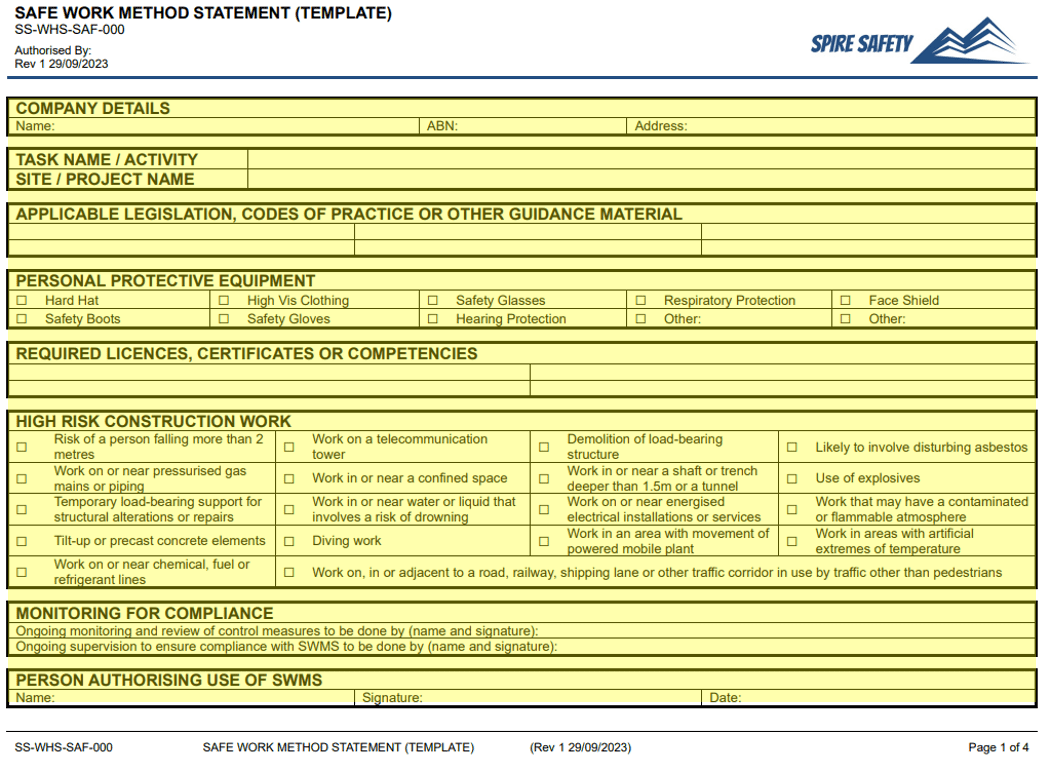
Step 2 – Fill Out the Task Steps and List the Hazards
List the task steps and hazards / risks associated with each step.
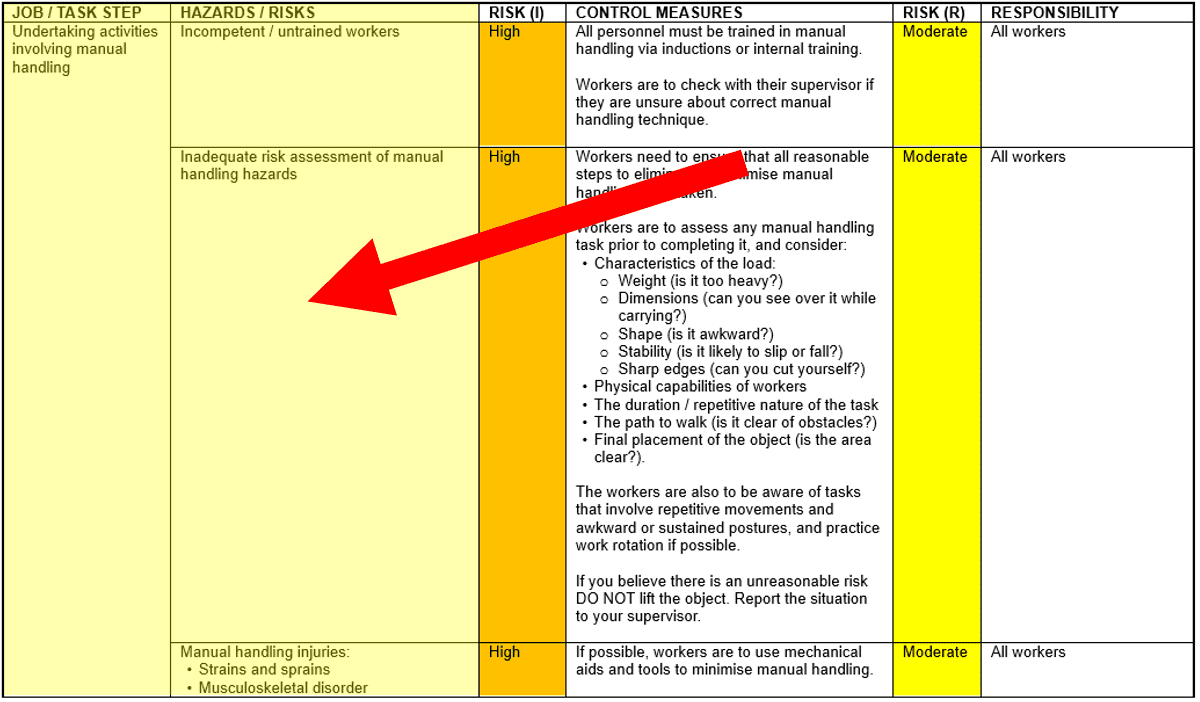
Step 3 – Risk Assessment (Initial Risk Score)
Next, you will need to use a Risk Matrix to score the risk (before controls are implemented).
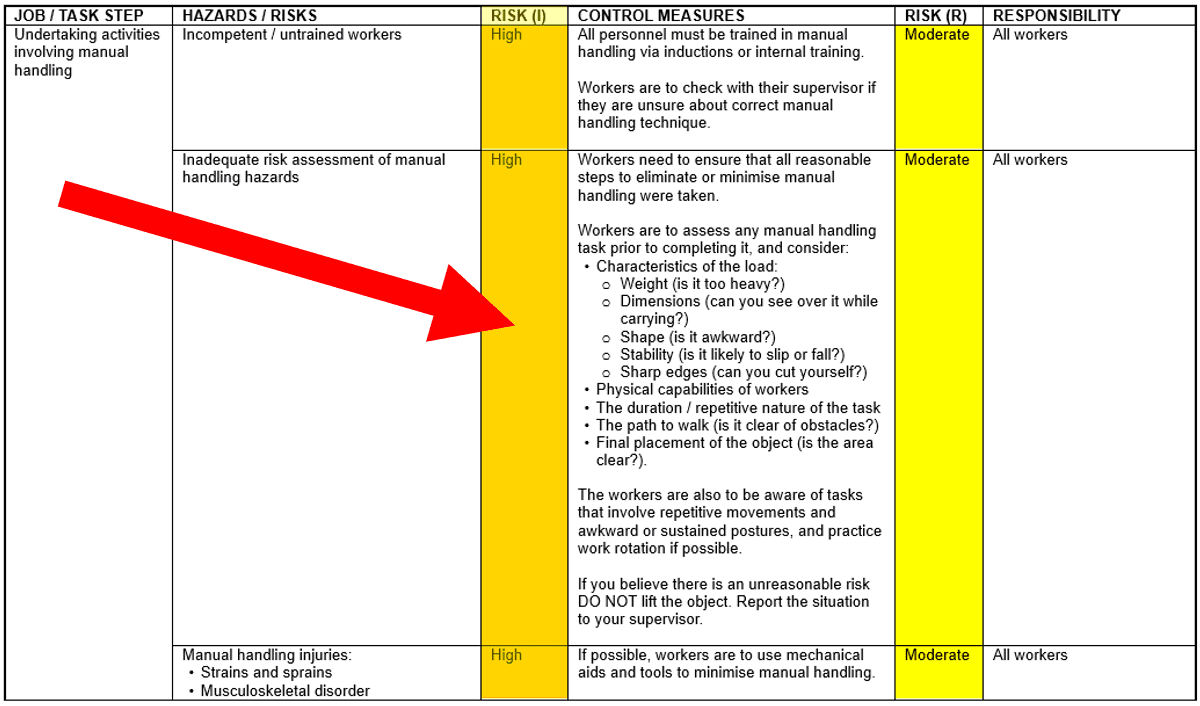
To score the risk, match up the consequence with the likelihood. An example risk matrix is below.
 Step 4 – List the Controls
Step 4 – List the Controls
Next list the controls to eliminate or minimise the risk associated with each hazard.
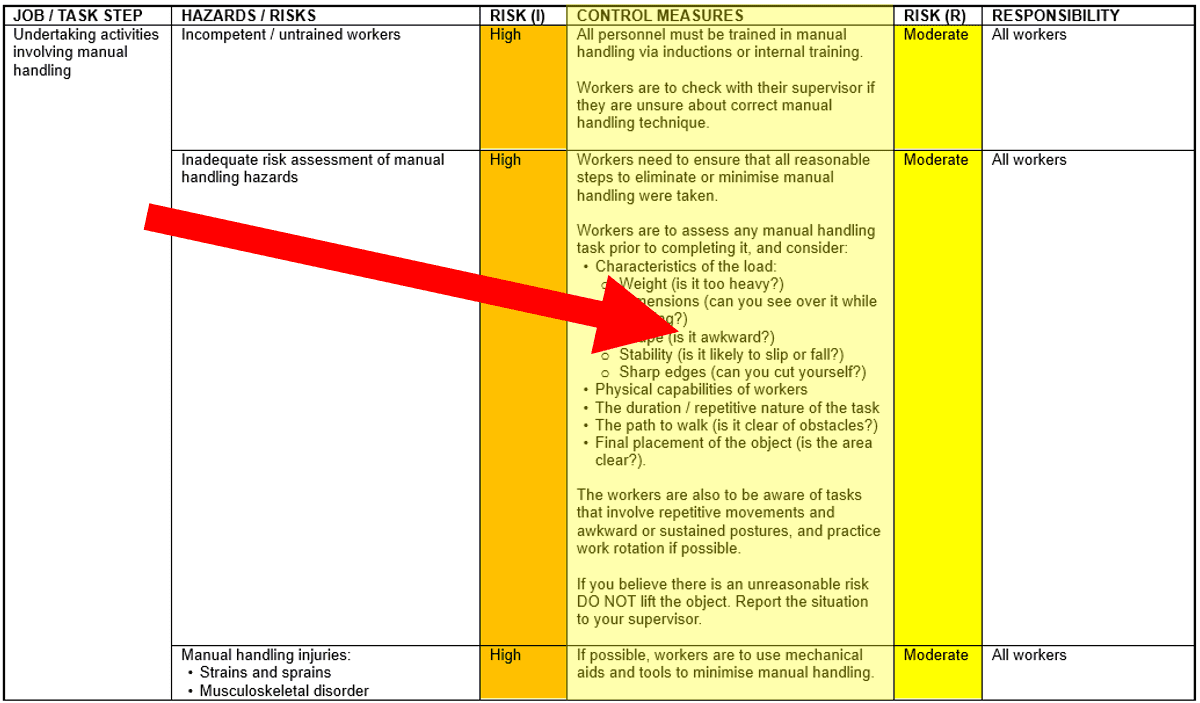
Step 5 – Risk Assessment (Residual Risk Score)
Finally, score the risk again, this time WITH CONTROLS. The risk should have reduced (hopefully to an acceptable level).
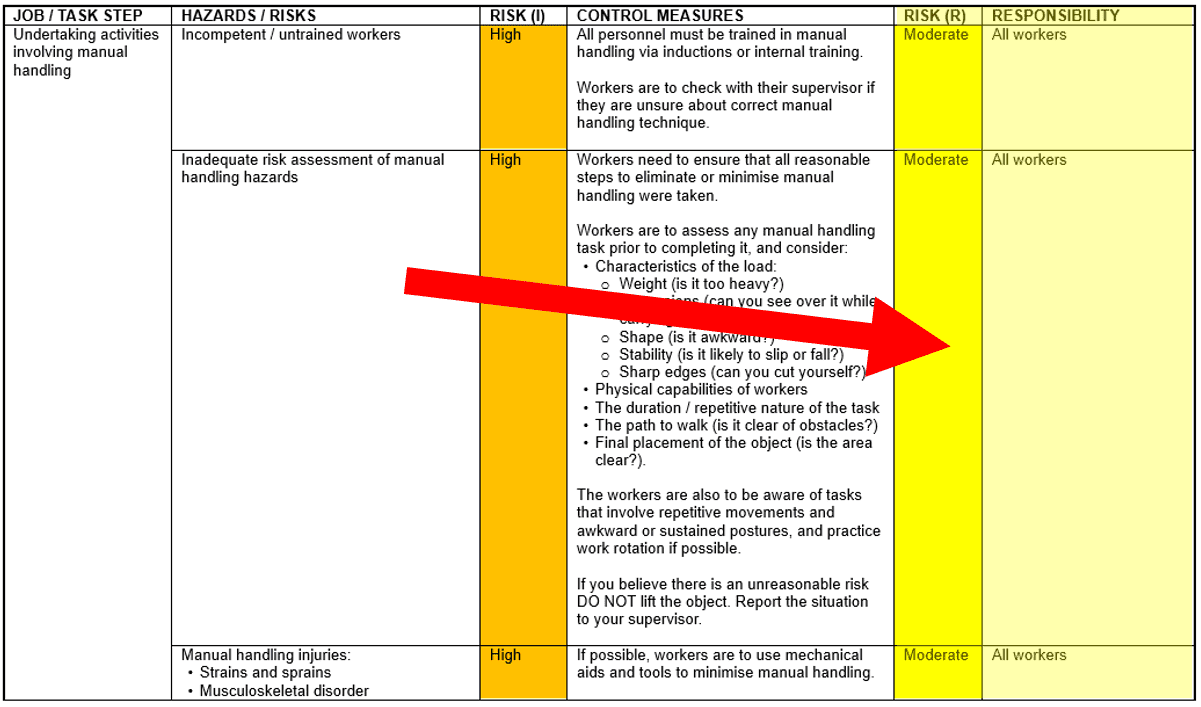
Also list who is responsible for implementing the controls.
What Else Can a SWMS Include?
Over the years, SWMS have evolved it more complex documents with additional contents. Additional info may include:
- PPE Requirements
- Licensing Requirements
- Permit Requirements
- The Hierarchy of Controls (for each control)
- Personnel Involved in SWMS Development
- Emergency Response Procedures and Equipment
Benefits of Safe Work Method Statements
Safe Work Method Statements can help workers and supervisors to implement and monitor the control measures established to make sure the work is carried out safely. A SWMS can also help managers, employees, and clients to ensure jobs have the proper planning, coordinate activities, resources, and protections needed to meet the safety regulations. A SWMS statement provides a way for businesses to communicate safety expectations clearly and concisely, which can save time and money in the long run. Additionally, method statements can provide a clear vision for safe work practices that everyone can follow and set high standards for safe work throughout an organization.
FAQs
What is a Safe Work Method Statement (SWMS)?
A Safe Work Method Statement (SWMS) is a document that outlines the high-risk construction work activities to be carried out at a workplace, the hazards arising from these activities, and the measures to be put in place to control the risks.
Who needs to prepare a Safe Work Method Statement?
The PCBU (Business / Business Owner) must ensure the SWMS is prepared by a competent person prior to high-risk construction work being undertaken.
What activities require a Safe Work Method Statement?
SWMS are required for all high-risk construction work.
How often should a Safe Work Method Statement be reviewed?
A SWMS should be reviewed regularly throughout the duration of the construction project, especially when there is a change in the nature of work, when a new hazard is identified, or after a work-related incident occurs. This ensures that the document remains relevant and effective in controlling identified risks.
Can a Safe Work Method Statement be reused for different projects?
Yes, however the SWMS should be reviewed prior to ensure risks are eliminated or minimised.
Further Reading
- What is a PCBU? (Spire Safety) <https://spiresafety.com.au/resources/what-is-a-pcbu/>
- High Risk Construction Work vs High Risk Work: The Difference (Spire Safety) <https://spiresafety.com.au/resources/high-risk-construction-work-vs-high-risk-work/>
- Safe work method statements (WHSQ) <https://www.worksafe.qld.gov.au/resources/guides/safe-work-method-statements>
